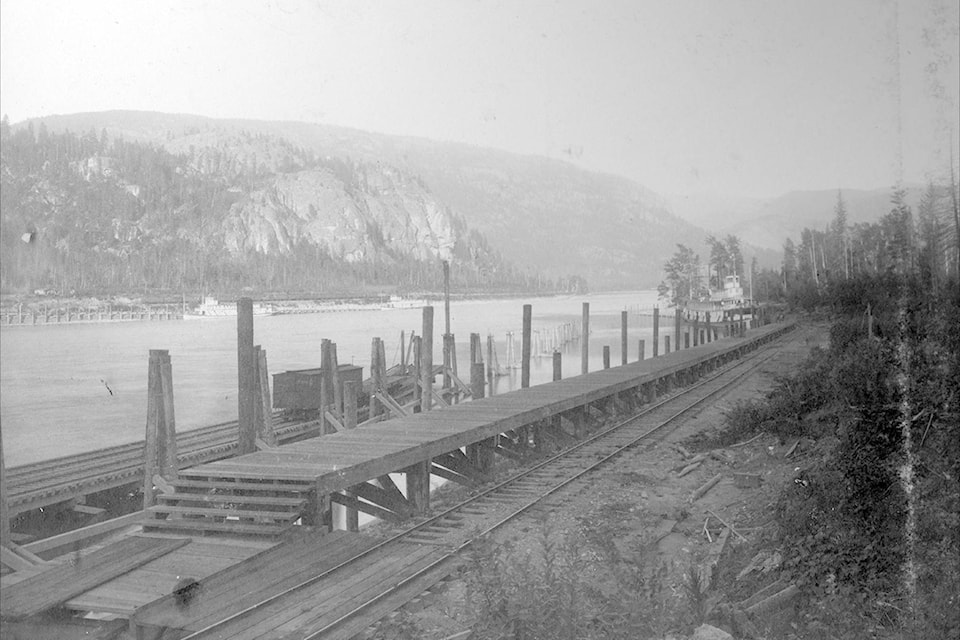During his inspection of the almost completed Columbia &Kootenay Railway, president William Van Horne derided the line as a ‘railway from nowhere to nowhere.’ It had been built to link Nelson to the CPR mainline via the Columbia River transportation pathway.
Constructed from Sproat’s Landing, it reached Nelson in May 1891. By August it had been extended to Robson, and the depot at Sproat’s Landing was closed.
During the next decade Van Horne would be proven wrong. Nelson, favoured by the CPR, became a divisional headquarters and a major maintenance centre.
The other end of the line would become a significant crossroads where three rail subdivisions joined and connected with the water route to the mainline.
In 1896 the railway company bought out existing steamship operations and launched its exemplary BC Lakes &Rivers Service, with Robson the primary terminus at the bottom of the run.
To get around winter freeze-up difficulties on the Columbia route, CPR constructed lines to Slocan Lake, and tapped into the recently discovered mineral wealth to the east, in direct competition with the Great Northern subsidiary line to Sandon. Next the company extended its line eastward from a landing at the south end of Kootenay Lake through the Crow’s Nest Pass to rejoin the mainline at Lethbridge.
This move further secured access to an area rich in mineral resources as well as the extensive coal deposits near the pass.
The final card was played on a drawn-out night in February 1898 when the company bought out Augustus Heinze, with his smelter, a railway from Rossland to a spot on a map called Castlegar, and a charter to extend it to the coast. When completed in 1916, the Kettle Valley Line would be the last component of the southern trans-provincial railway.
A couple of gaps remained for quite some time. The longest was along Kootenay Lake, and a barging service was implemented between Kootenay Landing and Nelson (later Procter). The second gap was shorter, but just as troublesome. In 1898 Robson became a hub of activity as the infrastructure for bridging this gap was put into operation.
At the western end of the railway a transfer slip ramp was constructed along which rail cars could be backed down onto a transfer barge. The barge was coupled to the ramp by an adjustable apron.
When loaded to capacity, a steamer pushed it to a similar slip across the river at West Robson, where it was unloaded and trains were reassembled for the trip to Trail.
They were carrying ore concentrates, coke, and coal to feed the smelter, which Walter Aldridge was modernizing with electric power from West Kootenay Power &Light Company.
A large engine house was located near the top of the Robson transfer slip; also a turntable in this location was mandatory to allow locomotives to be turned around.
Downstream of this industrial operation was the much longer ramp that allowed passenger trains to descend to the steamers tied up at the landing.
Robson, with its station, hotel, and several other business enterprises, was located on the flat bench directly above this sternwheeler ramp. Sternwheelers plied the Arrow lakes and serviced their various communities. With the railway to Trail operational, steamer travel downstream of Robson was no longer necessary. Excellent service, however, was maintained between Robson (and West Robson) and the railhead at Arrowhead until 1954.
Having acquired Heinze’s Columbia &Western Railway, CPR immediately launched an ambitious plan to improve the line they had bought, and to extend it westward in an effort to prevent Americans from exporting the mineral resources of the Boundary district to smelters south of the line.
With the advent of electricity, copper was becoming a valuable commodity. Improvements to the railway involved converting the steep line between Rossland and Trail from narrow to standard gauge. For a while a smelter war existed as Rossland was now serviced by both the CPR and a competing American line, which could haul concentrates to a smelter at Northport or points beyond.
Eventually a partnership was developed between the Trail smelter and several Kootenay mines; this became known as the Consolidated Mining &Smelting Company.
Extension of the Columbia &Western line to Midway proved to be a daunting and costly undertaking. It would prove to be the most expensive line in CPR history on a cost per mile basis.
The work was pushed at hectic speed through very difficult terrain, without relenting for adverse weather conditions.
That is an achievement that warrants its own story.
